-182 Porsche 356a Coupe (1958-66)
My last purchase this year is a Dinky Toys 182 Porsche 356a coupe in light blue with cream ridged hubs, without box. I like this shiny light blue colour with cream ridges hubs.
No topic had been started yet about this well-known German car and because at the introduction of model 182 by the Toyman in MM of September 1958 not a single detail was mentioned about the prototype, so I went looking for details myself.
Personally, I got to know the Porsche 356 as a road user on the Dutch highways in the 60’s. Every Dutch highway user knows the Porsche 356 and all subsequent types of Porsches that was employed as a patrol car by the General Traffic Service (AVD) of the Rijkspolitie (National Police) on the Dutch highways from 1962 till 1994. Every motorist was in awe of these fast cars when you saw them approaching in the mirror at high speed. The high speed together with the roaring sound of the air-cooled boxer engine at the rear of this car when overtaking on the highways makes much impression and you immediately complied with the traffic rules. It's an interesting car to know more about.
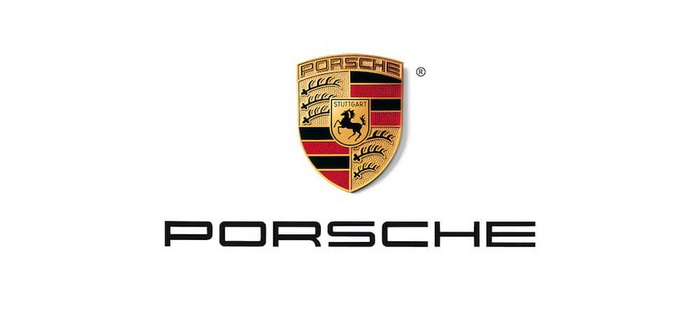
Porsche logo
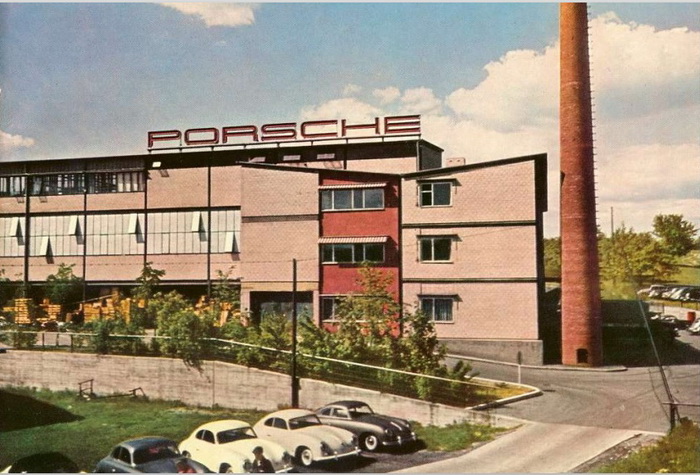
PORSCHE 356. (autoweek.nl translated)
The much-described Porsche history naturally starts with the 356. Or rather with a 'streamline car' that did not yet have a type designation. Before the war, three of those sports cars had been built by Doktor Porsche in Gmünd, Austria. His son Ferry had drawn the lines and the cars were intended for a race from Berlin to Rome. The 356 that emerged from it in 1950 was basically not too different from these racing cars. 1950 was also the year that Porsche moved into a factory in Stuttgart, Germany, and production started from there. The first type 356 still had a windscreen consisting of two flat pieces, but from 1952 these were replaced by a single curved one. Engines were four-cylinder boxers with a displacement of 1,086; 1,268; 1,290 or 1,488 cc and the power therefore varied from 40 to 60 hp.
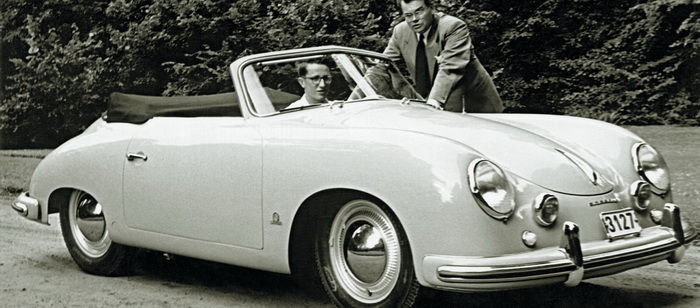
First type Porsche 356 with a windscreen consisting of two flat pieces. From 1952 these were replaced by a single curved one.
The 356 was popular on circuits and in rallies and when a 356 won the Mexican Carrera Panamericana, it was decided to build a super fast version under the name 'Carrera'. This had double overhead camshafts and could be boosted well above 6,000 rpm. The power was around 100 hp.
After the 356, the 356A followed in 1955, which was also marketed as a Cabriolet and Speedster. The engine has now been enlarged to 1,582 cc and delivers 60 to 75 hp. The Speedster is especially for the American market and is very popular there.
In 1959 the 356A is succeeded by the 356B. Bumpers and headlights have been placed higher and the interior has also been overhauled. There will be a 'Super 90' version with 90 hp and improved rear suspension and the Speedster will be called Roadster from now on. Of course, a Carrera version of the 356B will also appear. This time it has 1,966 cc of no less than 130 or even 155 hp. Disc brakes all around are standard.
The last of the 356s comes on the market in 1963 and is of course called 356C. Disc brakes all around were now standard and power from the 1,582 cc boxer is now standard at 75 or 95 hp (the SC). After only two years, the production of the 356C comes to an end: after all, the 911 is already ready in 1965 as a successor.

25th Company's Anniversary of Porsche and production of 10.000th Porsche sportscar on 16-3-1956. (Porsche museum postcard).

The German Autobahn Polizei also drove Porsche 356 convertibles. Here with a visit from French colleagues 30 June 1959. If you look closely at the French caps you will discover Louis de Funès of the Gendarme de Saint-Tropez among them.

Porsche 356 Dutch police highway patrol - (AVD) Algemene Verkeersdienst Rijkspolitie (1962-1994)
Because the Meccano Assembly Drawing of the Porsche 356a is dated 29-1-57 and looking at various brochures I think the prototype of DT 182 is of model year 1956.

1956 sales brochure Porsche 356 front side.
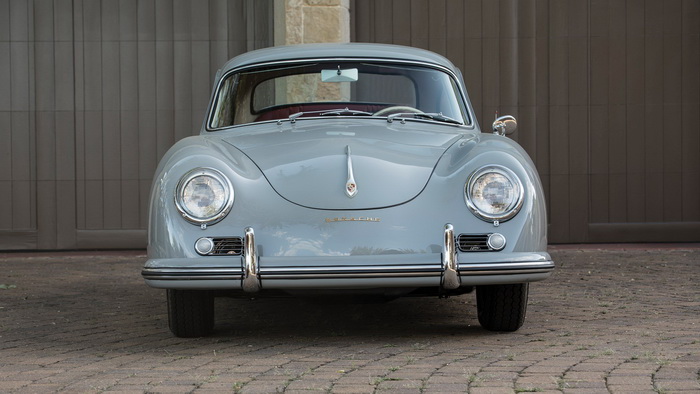
1956 Porsche 356a European Coupe RM Sotheby's Monterey 11 August 2019. Accurately restored.

My 182 Porsche 356a coupe front.

1956 sales brochure Porsche 356 coupe
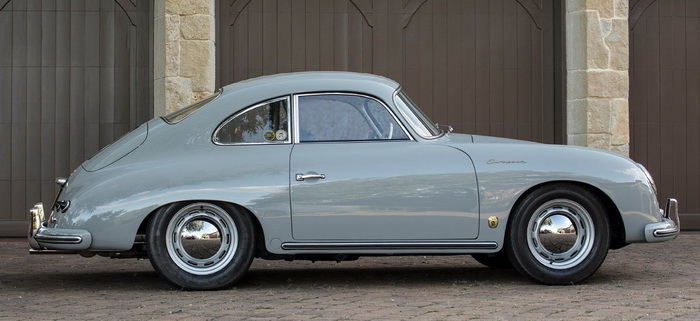
1956 Porsche 356a European Coupe
This exceptional 356 A coupe is adorned with the very rare and seldom-seen golden European fender script, affixed to only the earliest 1956 Porsche cars destined for the American market.

European fender script

DT 182 front right with ridged hubs.

1956 sales brochure Porsche 356 rear side.

Dashboard Porsche 356

1956 Porsche 356a European Coupe rear side. Note the type lettering in gold.

DT 182 left rear side.
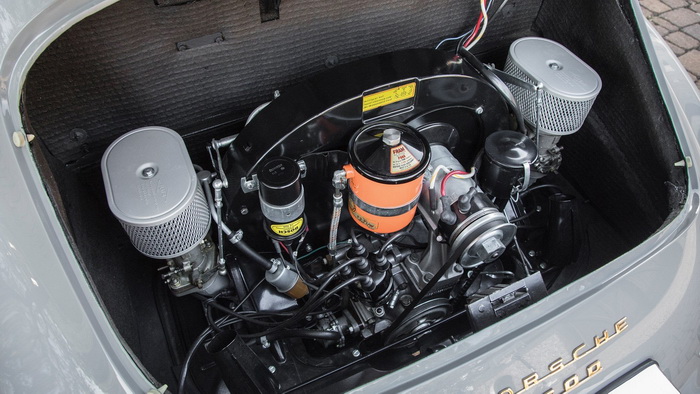
Air cooled four-cylinder boxer engine behind the rear axle.

Partial 1956 brochure with technical data.
I also went looking for a Meccano drawing and found it in the DTCA PDF library, in Jacques’s encyclopaedia and on de website of QDT. The Meccano Body drawing Porsche 356a is Job No. 14388 dated 18-10-56. The Meccano assembly drawing of the Porsche 356a is Job No. 14387 dated 29-1-57.

Meccano drawing Body Porsche 356a Job No. 14388 dated 18-10-56. Photo PDF library of DTCA.

Dinky Toys 182 Meccano assembly drawing Porsche 356a dated 29-1-57. Photo with courtesy of QDT.
Note: In the description of change on the Job list No. 14387 above states that the wheels and axles were changed on 30-4-59. This should be done for fitting of the concave "spun" hubs, so the ridged hubs are mounted for a very short time (July 1958 – April 1959).

Dinky Toys 182 Porsche 356a coupe were 1st advertised in MM september 1958 together with 180 Packard Clipper, both with ridged hubs. It was already included in the Meccano products price list UK of July 1958 and UK leaflet of January 1959.
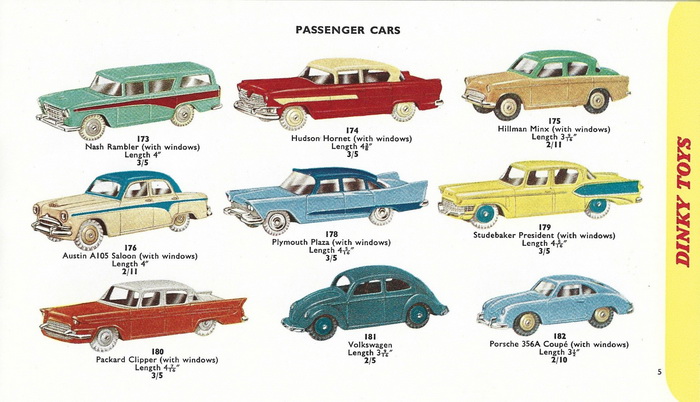
DT 182 for the first time in DT catalogue UK 1959 with convex ridged hubs.
The 182 is classified under passenger cars, but in fact the Porsche 356a is more a sports/racing car with room for 2 passengers and a rear seat for the luggage.
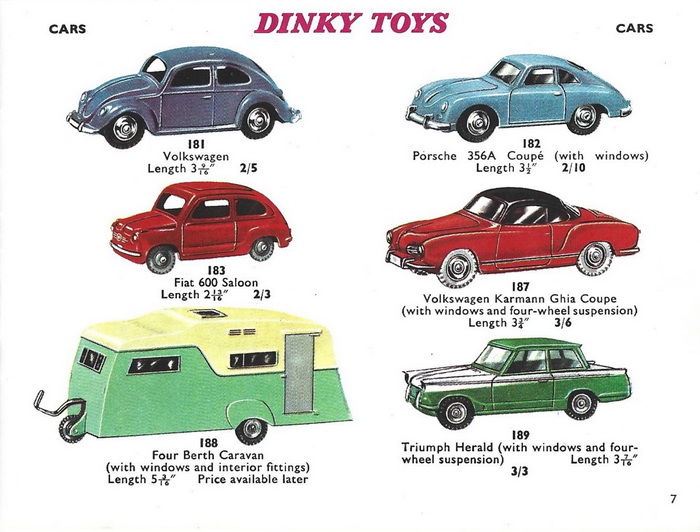
Dinky Toys 182 in catalogue UK 1960, from now on with concave “spun” hubs.
All 182’s got windows and a baseplate with sales number 182. It got 3 versions baseplates: 1st mottled; 2nd black gloss; 3rd matt black.

My 182 with mottled baseplate with salesnumber 182.
Note: One thing puzzles me. Ramsay's model toys catalogue mentions in the list with description of the models under 182 as the penultimate version: "red body, silver painted hubs and gloss black base", as Jonathan acquired and post in new arrivals #1705, pictured below.

182 red body with silver cast concave hubs
Ramsay calls them silver painted hubs, Vectis calls them cast spun hubs and QDT calls them silver cast (not spun) wheels. I am not familiar with metals to explain this type of hubs. Are they aluminium concave hubs with a silver finish? In what kind of process did these hubs get a silver finish? Were these and spun hubs made by Meccano Liverpool itself or from outside?
Strange that Meccano Liverpool first fitted aluminum spun hubs to the 182 and the later red version of the 182 got silver cast hubs. In December 1958 the 192 De Soto Fireflite was fitted with aluminum spun hubs for the first time and seems to be becoming the standard. The spun hubs look smooth and shiny and has a chrome look. The silver cast hubs has a more silver look but given the examples apparently also more susceptible to paint damage. Was this a try-out of Meccano Liverpool? It seems to me that it has not been followed up in a wide range.
Note: This question is also discussed in topic “Wheel variations” by Bruce Hoy and Adrian Nash under #170, #234 en #237 with pictures of silver cast hubs of 148 Ford Fairlane, 167 A.C. Aceca and 405 Universal Jeep. I found still 2 more silver cast hubs of DT 259 Fire Engine in topic 259 #6 and DT 257 Fire Chief’s car in topic 257 #3, both of Bruce Hoy. So I found a total of 6 DT’s with silver cast hubs. But perhaps there are more.
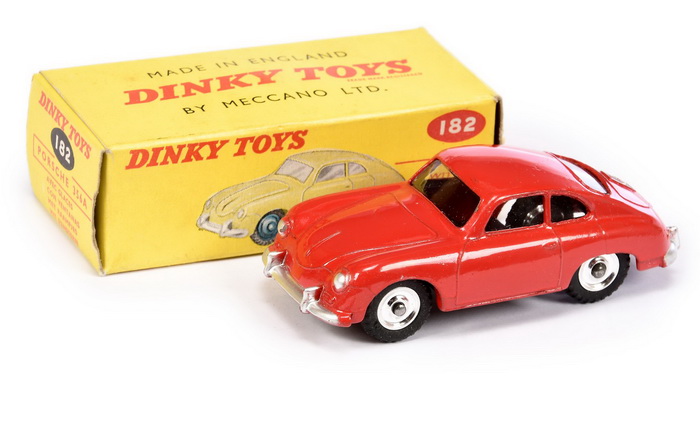
182 red body with shiny aluminium concave “spun” hubs. Photo with courtesy of Vectis.
There is more special about the 182 red versions. I have examined baseplates of several 182 and it struck me that several 182 red versions have one or both red coloured rivets while rivets were never painted by Meccano Liverpool. I show a photo from QDT of such a red version with silver cast wheels and a gloss black baseplate with red coloured rivets and a red version with spun hubs with a matt black baseplate with one red coloured rivet, auctioned at Ebay Italy. It looks not hand painted but probably caused by the rivet machine? And how to judge the two last pictures of a red 182 with silver cast hubs and two red coloured rivets auctioned at Ebay UK? I show these photos in full size at the end so that they can be better judged. Opinions on this?
These pictures also shows the 3 versions of base plates. The 182 have various colour variants and box types. I hope members will post pictures of them and make additions.
Jan Oldenhuis 17-12-2022.
Thank you for this lovely contribution, Jan.
As usual, Jan, a wonderful article. Many thanks.
Jan
Yes, a very nice article and great research. Just a note, since I am from the US: very early 356 export models to the USA were called Continentals (around 1955 or so), but only for a short time. A good friend of our family had a brand new one then, and I got to see it several times....a lovely car! Dinky made a nice model of it, but the models sits quite a bit higher off the road than the real car, and the tires also appear a bit too large.....but that is nit picking.....it's still a nice model!
Best regards,
Terry
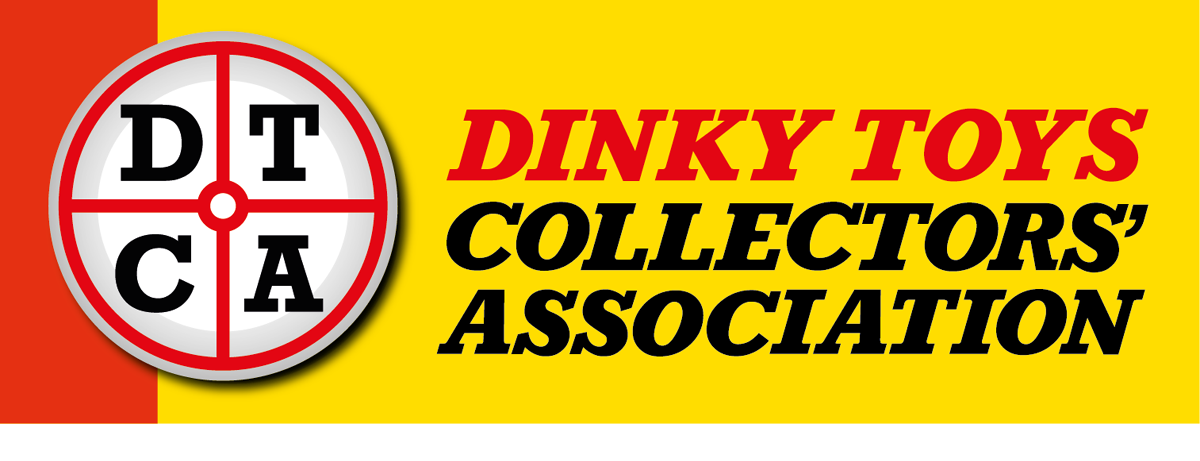

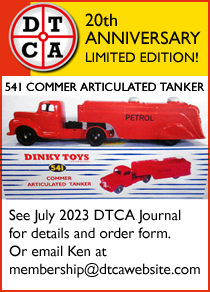

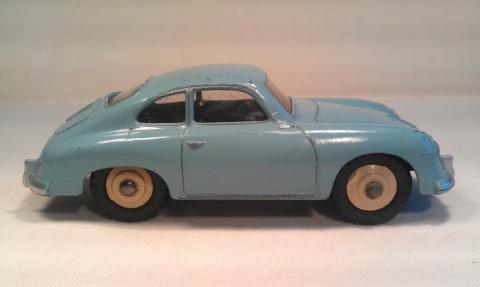
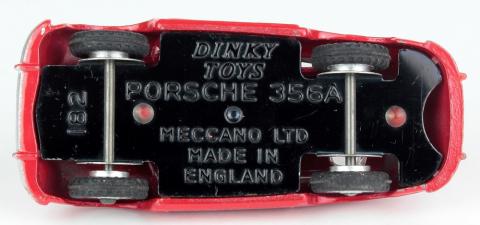




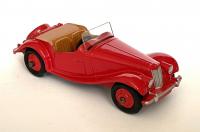
-914 AEC Articulated Lorry (1965-70)
-163 Bristol 450 Sports Coupé (1956-60)
-163 Bristol 450 Sports Coupé (1956-60)
-914 AEC Articulated Lorry (1965-70)
DTCAwebsite upgrade 2023
DTCAwebsite upgrade 2023
DTCAwebsite upgrade 2023
DTCAwebsite upgrade 2023
DTCAwebsite upgrade 2023
DTCAwebsite upgrade 2023
-508 DAF
--14c and 401Coventry Climax Fork Lift Truck (1949-64)
FRENCH DINKY TALBOT LAGO
-Boxes General Discussions including end flaps, both British and French
--14c and 401Coventry Climax Fork Lift Truck (1949-64)
--14c and 401Coventry Climax Fork Lift Truck (1949-64)
-508 DAF
DTCAwebsite upgrade 2023
DTCAwebsite upgrade 2023
DTCAwebsite upgrade 2023
DTCAwebsite upgrade 2023
DTCAwebsite upgrade 2023
-508 DAF
-508 DAF
-508 DAF
New arrivals
New arrivals
DTCAwebsite upgrade 2023
DTCAwebsite upgrade 2023
ORIGINAL MECCANO DINKY TOYS FACTORY BOX ART 175 HILLMAN MINX SALOON + DRAWING
--29c and 290 Double Decker Bus (1938-63)
DTCAwebsite upgrade 2023
DTCAwebsite upgrade 2023
DTCAwebsite upgrade 2023
DTCAwebsite upgrade 2023